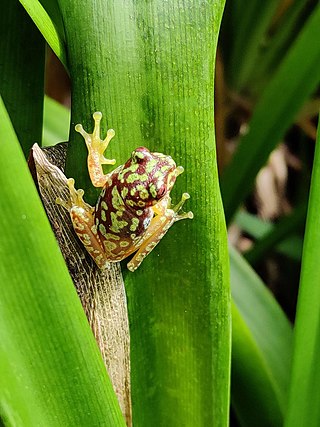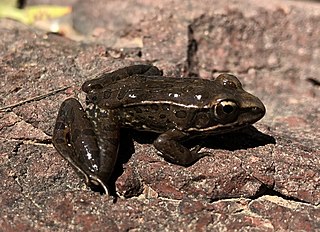
The Pine Barrens tree frog is a species of New World tree frog. It is becoming rare due to habitat loss.
Aromobates alboguttatus is a species of frog in the family Aromobatidae. It is endemic to the Andes in the Táchira and Mérida states, western Venezuela.The synonymy of Colostethus inflexus is still not fully resolved.

The Betic midwife toad or Sapo Partero Bético is a species of frog in the family Alytidae. It is endemic to mountainous in south eastern Spain. Its natural habitats are temperate forests, freshwater marshes, intermittent freshwater marshes, pastureland, ponds, and aquaculture ponds. It is threatened by habitat loss.

The Tyrrhenian painted frog is a species of frog in the family Alytidae.
The yellowbelly voiceless tree frog is a species of frog in the family Hylidae endemic to Mexico.

The Copan brook frog is a species of frog in the family Hylidae found in northeastern Guatemala and northwestern Honduras, specifically in the Sierra del Merendón, Sierra de Omoa, Sierra de Caral, and Sierra Espíritu Santo ranges. The colouring of this species is very distinctive and the specific name soralia comes from the resemblance of its markings to the vegetative structures on some crustose lichens.
The Hispaniolan yellow tree frog, or common treefrog, is a species of frog in the family Hylidae endemic to Hispaniola, where it is found in both the Dominican Republic and Haiti.
Quilticohyla acrochorda, commonly known as the warty mountain stream frog, is a species of frogs in the family Hylidae. It is endemic to Mexico and known from the Atlantic slopes of the Sierra Juárez in Oaxaca. Before being described as a new species in 2000, it was mixed with Ptychohyla erythromma. The specific name acrochorda is a Greek word for "wart" and refers to the distinctive white warts on the posterior surface of the thigh of this frog.
Ptychohyla dendrophasma is a species of frog in the family Hylidae found in Guatemala and possibly Mexico. Its natural habitat is subtropical or tropical moist montane forests. It is threatened by habitat loss.
The cloud forest stream frog is a species of frog in the family Hylidae found in El Salvador, Guatemala, Mexico, and possibly Honduras. Its natural habitats are subtropical or tropical moist lowland forest, subtropical or tropical moist montane forest, and rivers. The cloud forest stream frog's lower elevation limit sits at 500 meters and it's upper elevation limit is at 2,200 meters. The frog's current population trend is suspected to be decreasing due to the ongoing degradation in the quality and extent of its environment. It is common in Guatemala and Mexico, but the population status in Honduras and El Salvador are unknown. It is threatened by habitat loss. These frogs are semiaquatic, living both terrestrially and in inland freshwater.

The Copan stream frog is a species of frogs in the family Hylidae found in Guatemala, Honduras, Nicaragua, and possibly El Salvador. Its natural habitats are subtropical or tropical moist lowland forests, subtropical or tropical moist montane forests, rivers, pastureland, and heavily degraded former forests. It is threatened by habitat loss.
Legler's stream frog is a species of frogs in the family Hylidae found in Costa Rica and Panama. Its natural habitats are subtropical or tropical moist lowland forests, subtropical or tropical moist montane forests, and rivers. It is threatened by habitat loss.
Schultze's stream frog is a species of frog in the family Hylidae endemic to Mexico. It is only known from the Pacific slopes of the Sierra Madre del Sur in Oaxaca and Guerrero states. Its natural habitats are pine-oak and cloud forests. It occurs in or on low vegetation along mountain streams. It is anuncommon species threatened by habitat loss from deforestation and the planting of coffee and other non-timber plantations. Also chytridiomycosis is suspected.
Atlantihyla panchoi, also known as the Guatemala stream frog, is a species of frog in the family Hylidae. It is endemic to eastern Guatemala and is only known from three localities in the Sierra de las Minas and Montañas del Mico ranges. The specific name panchoi honors Laurence Cooper "Don Pancho" Stuart, an American herpetologist.

Ptychohyla salvadorensis is a species of frog in the family Hylidae found in El Salvador, Guatemala, and Honduras. Its natural habitats are subtropical or tropical moist montane forests, rivers, pastureland, and heavily degraded former forests. It is threatened by habitat loss.

Ptychohyla zophodes is a species of frogs in the family Hylidae. It is endemic to Mexico and known from the Atlantic slopes of the Sierra Madre de Oaxaca in northern Oaxaca and adjacent central-western Veracruz. Before being described as a new species in 2000, it was mixed with Ptychohyla leonhardschultzei. The specific name zophodes is a Greek word meaning "dusky" or "gloomy" and refers to the distinctive dark coloration of the species as well as its cloud forest habitat. Common name gloomy mountain stream frog has been coined for it.
Gunther's robber frog, Günther's robber frog, or Guerreran robber frog is a species of frog in the family Craugastoridae. It is endemic to the Sierra Madre del Sur in the Guerrero state, Mexico. Its natural habitats are pine, oak, and pine-oak forests with plenty of leaf-litter on the ground. It is a relatively common species but declining and threatened by habitat loss and disturbance.
Nothophryne broadleyi is a species of frog in the family Pyxicephalidae found on Mount Mulanje (Malawi). It was monotypic within the genus Nothophryne until four new species were described in 2018.

The transverse volcanic leopard frog is a species of frog in the family Ranidae endemic to the southern edge of the Mexican Plateau, Mexico. Its natural habitats are pine-oak forests and mesquite grasslands near lakes, pools or slow-flowing streams. It is threatened by habitat loss.
The Puebla frog or Pueblan pool frog is a species of frog in the family Ranidae endemic to Necaxa River near Huauchinango, Puebla state, Mexico, where it is known as rana poblana. It was thought to probably be extinct until 2010 when Dr. Georg Hantke from the National Museum of Scotland re-discovered it.








